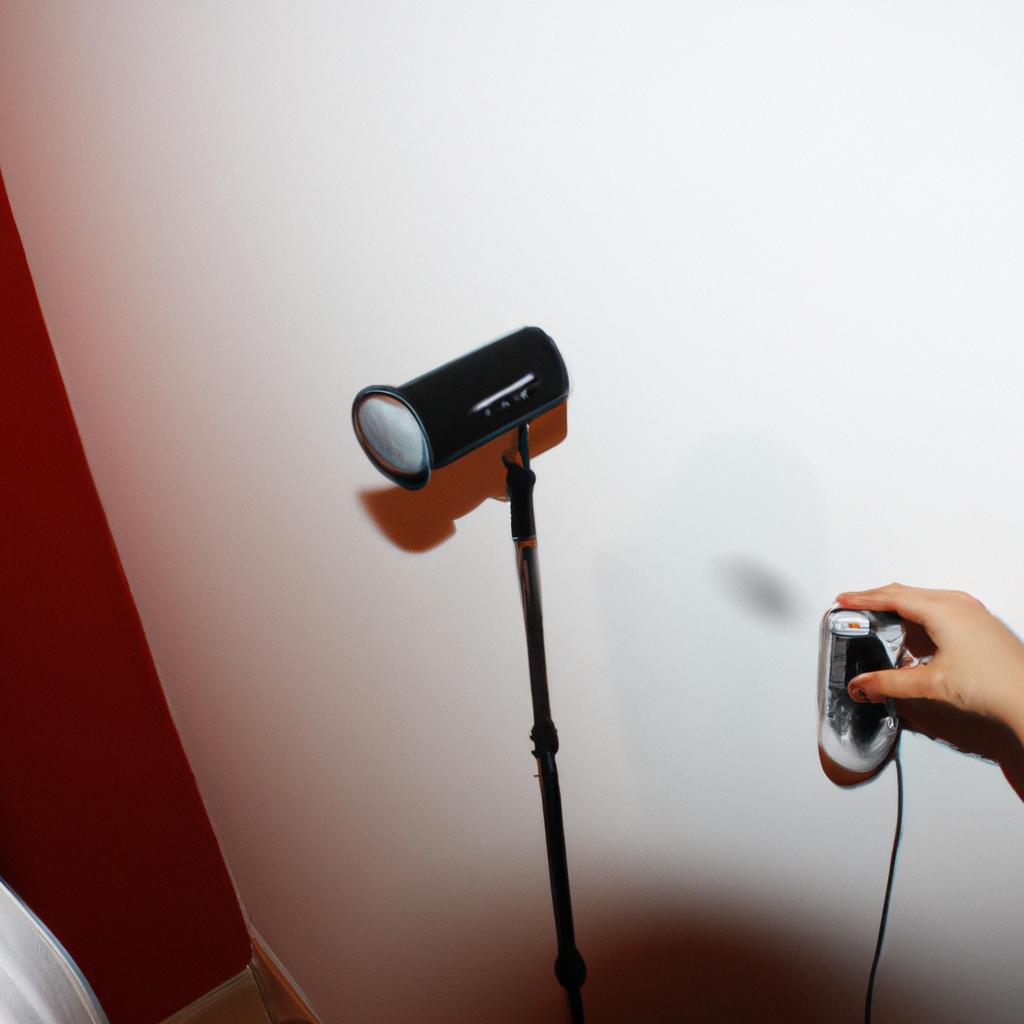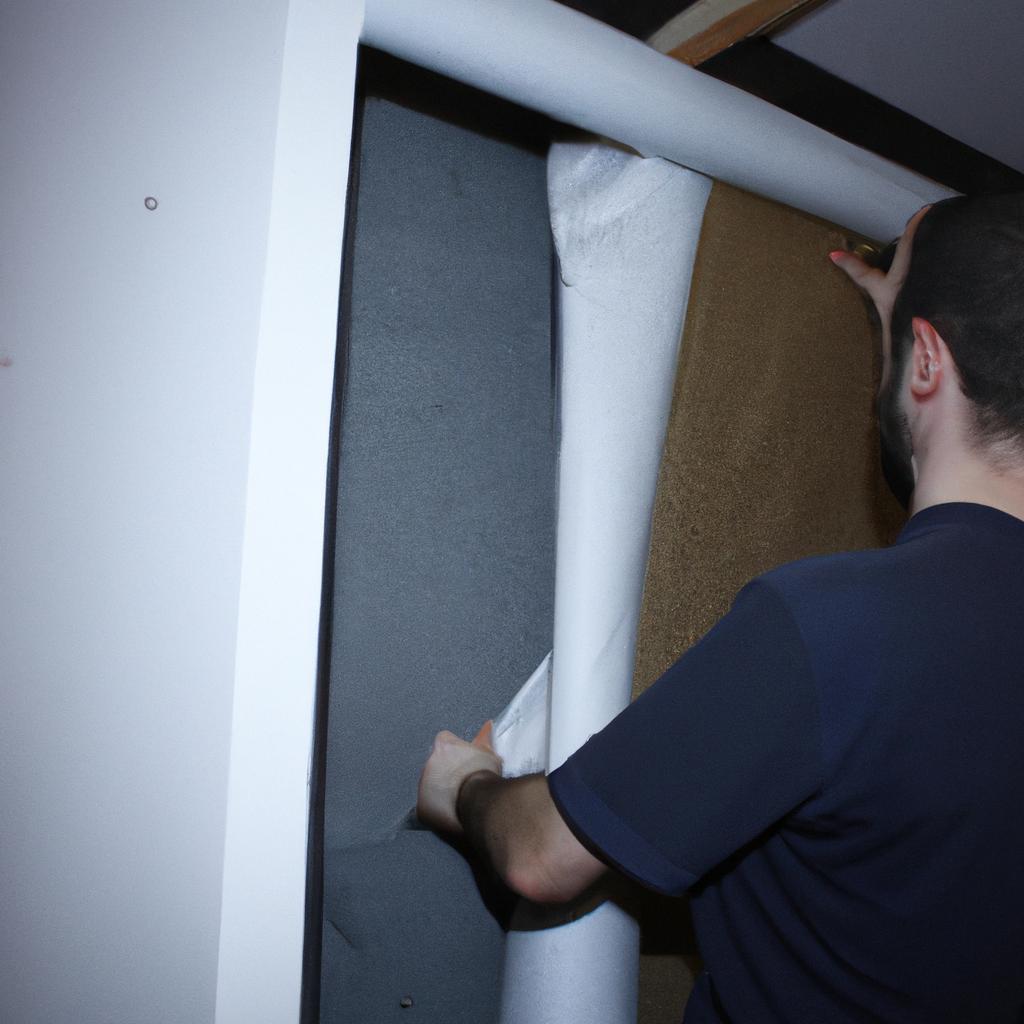Room acoustics play a crucial role in optimizing sound and vision within an environment. The way sound waves interact with the surfaces and objects in a room can greatly impact the quality of audio reproduction, as well as the overall experience for viewers or listeners. For instance, imagine a small home theater where the walls are bare and reflective, causing sound waves to bounce around chaotically, resulting in poor clarity and muddled dialogue. In contrast, envision another scenario where a concert hall is meticulously designed with diffusive panels and absorbent materials strategically placed to enhance acoustic performance, allowing each note from the orchestra to be heard with pristine clarity.
To achieve optimal sound and vision in any given space, it is essential to understand the principles of room acoustics. This field encompasses various factors that contribute to the successful manipulation of sound within an enclosed area. These factors include but are not limited to room size, shape, reflective properties of surfaces, placement of speakers or instruments, absorption coefficients of materials utilized, diffusion techniques employed, and more. By considering these elements carefully during the design phase or retrofitting process of a space, one can create an environment that maximizes both auditory enjoyment and visual immersion for users across diverse applications such as home theaters, recording studios, conference rooms, concert halls, and classrooms.
When it comes to room acoustics, there are several key concepts to consider. One of the most important is reverberation time, which refers to how long sound lingers in a space after the source has stopped emitting sound. This can greatly affect the clarity of audio reproduction, as excessive reverberation can cause sounds to blend together and become indistinct.
Another crucial consideration is absorption, which involves using materials that absorb sound waves rather than reflect them. This helps reduce unwanted echoes and reverberations within a room. Absorption coefficients measure how much sound energy is absorbed by different materials at various frequencies.
Diffusion is another technique used in room acoustics. It involves scattering sound waves in multiple directions instead of allowing them to be reflected directly back towards the listener or microphone. Diffusive panels or surfaces help create a more even distribution of sound throughout the space, enhancing clarity and preventing localized “hot spots” or “dead zones.”
The positioning and placement of speakers or instruments also play a significant role in optimizing room acoustics. Proper speaker placement ensures an accurate stereo image and balanced frequency response across different listening positions. In recording studios, careful microphone placement helps capture desired sounds while minimizing unwanted ambient noise.
To optimize room acoustics, professionals often employ various tools such as acoustic panels, bass traps, diffusers, and reflective surfaces strategically placed throughout the space. These elements can be customized based on the specific needs and objectives of the environment.
In summary, understanding room acoustics is essential for creating environments that provide optimal sound and vision experiences. By considering factors such as room size, shape, reflective properties of surfaces, absorption coefficients of materials used, diffusion techniques employed, and proper positioning of speakers or instruments, one can design spaces that enhance audio reproduction quality and visual immersion across diverse applications.
Understanding Room Reflections
Imagine sitting in a home theater, eagerly awaiting the start of your favorite movie. As the lights dim and the opening credits roll, you notice something amiss—the sound seems muffled and lacks clarity. Frustrated, you try adjusting the volume, but it does little to improve the experience. What could be causing this distortion? The answer lies within the complex phenomenon known as room reflections.
Room reflections occur when sound waves bounce off surfaces such as walls, floors, and ceilings before reaching our ears. These reflected sounds can interfere with direct sound waves, leading to a degradation in audio quality. To better understand this concept, consider a hypothetical scenario where an individual is speaking in a room filled with hard surfaces. Instead of hearing their voice directly from their mouth, we hear multiple versions of their voice—each one bouncing off different surfaces—causing echoes and reverberations that make it challenging to decipher what they are saying.
To grasp the impact of room reflections on audio perception, let’s explore some key factors:
- Sound decay: When sound waves reflect off surfaces repeatedly, they lose energy over time due to absorption and diffusion. This causes a delay between direct and reflected sounds.
- Frequency response: Different frequencies behave differently when reflecting off surfaces. High-frequency sounds tend to reflect more readily than low-frequency ones.
- Comb filtering: When two identical sound waves interact—one direct wave and its corresponding reflection—they can either amplify or cancel each other out at different frequencies.
- Sweet spots and dead zones: Depending on the positioning of speakers and listeners within a room, certain areas may have enhanced or diminished acoustic performance.
| Factors | Description |
|---|---|
| Sound Decay | Gradual reduction in amplitude caused by repeated reflections |
| Frequency Response | Variations in how different frequencies reflect off surfaces |
| Comb Filtering | Interference patterns created by direct and reflected sound waves |
| Sweet Spots and Dead Zones | Areas within a room that exhibit enhanced or diminished acoustic properties |
Understanding the impact of room reflections is crucial when designing an optimal listening environment. By addressing these factors, we can minimize unwanted echoes, improve audio clarity, and create a more immersive experience for movie enthusiasts like yourself.
Transitioning seamlessly into the next section about “Absorbing Sound with Acoustic Panels,” let us explore how introducing acoustic panels can effectively mitigate the negative effects of room reflections.
Absorbing Sound with Acoustic Panels
Optimizing Room Reflections for Enhanced Acoustics
Imagine you are sitting in a beautifully designed home theater, eagerly waiting for the movie to start. You have meticulously chosen the perfect sound system and visual display, but as soon as the movie begins, you notice an unpleasant echo that muddles the dialogue and distracts from the immersive experience. This is where understanding room reflections becomes crucial in creating an optimal acoustic environment.
To minimize unwanted echoes and ensure pristine sound quality, there are several key factors to consider:
-
Placement of speakers: Carefully positioning your speakers can significantly impact how sound waves interact with your space. Experimenting with different speaker locations can help identify positions that minimize reflections and create a more balanced soundstage.
-
Utilize furniture and decor strategically: Incorporating elements such as curtains, bookshelves filled with books, or even plush seating can help absorb excess sound energy and reduce reflections within the room. By strategically placing these items around your listening area, you can effectively control reverberation times.
-
Explore acoustic treatments: Installing wall panels or diffusers specifically designed to address room reflections can greatly enhance your audio experience. These treatments come in various forms and materials, each catering to different frequency ranges and reflection angles.
-
Consider room dimensions: The size and shape of your room play a significant role in its acoustic properties. Irregularly shaped rooms tend to produce less prominent standing waves compared to rectangular ones due to fewer parallel surfaces; however, they may introduce other challenges related to flutter echoes.
By implementing these strategies, you not only improve speech intelligibility but also elevate music listening sessions or cinematic experiences by providing clear separation between instruments or effects channels—a vital element for any enthusiast seeking sonic immersion.
Table: Advantages of Optimized Room Reflections
| Benefit | Description |
|---|---|
| Enhanced clarity | Minimized reflections result in improved intelligibility of dialogue or music |
| Immersive experience | Reduced room echo allows for a more enveloping and engaging audio response |
| Accurate sound staging | Properly managed reflections create a precise sense of instrument placement |
| Reduction in listening fatigue | Reducing excessive reverberation prevents listener exhaustion |
In the pursuit of perfect acoustics, understanding how to optimize room reflections is just one step. By employing both techniques, you can achieve an immersive audio environment that truly complements your visual setup without compromise.
Diffusing Sound with Diffusers
Building off the concept of absorbing sound with acoustic panels, let us now explore another important aspect of room acoustics—diffusing sound with diffusers. By strategically dispersing sound waves in various directions, diffusers play a crucial role in optimizing both the auditory experience and visual aesthetics within a space.
Diffusers are designed to scatter sound reflections evenly throughout a room, reducing echo and reverb while maintaining clarity and intelligibility. This effect can be particularly beneficial in spaces such as recording studios, concert halls, or home theaters where precise audio reproduction is essential for an immersive experience. To illustrate this point, consider a hypothetical scenario wherein a music studio incorporates diffusers on its walls and ceiling. As musicians record their tracks, the diffusers help minimize unwanted echoes caused by hard surfaces, resulting in cleaner recordings that accurately capture each instrument’s nuances.
To better understand how diffusion works and its impact on our perception of sound quality, let us delve into some key features and benefits:
- Enhanced spatial impression: Diffusers create a sense of spaciousness by breaking up direct reflections from walls and ceilings into smaller scattered reflections. This enhances the listener’s perception of depth and width within the listening environment.
- Improved frequency response: Diffusion helps mitigate standing waves—a phenomenon where certain frequencies resonate excessively within a confined space—resulting in more balanced bass reproduction.
- Aesthetically pleasing design options: Diffuser panels come in various shapes, sizes, and materials that can complement any interior design style while serving their primary acoustic function.
- Flexible installation possibilities: Whether installed on walls or suspended from ceilings, diffusers offer versatility in placement options to cater to specific room dimensions and requirements.
Letting diffuse sounds envelop your senses creates an enriched auditory experience that seamlessly integrates with visually appealing surroundings. In our next section about controlling bass with bass traps, we will further explore how managing low-frequency reverberations can contribute to achieving optimal room acoustics.
Controlling Bass with Bass Traps
Section Transition from ‘Diffusing Sound with Diffusers’:
Having explored the benefits of diffusing sound to achieve a balanced acoustic environment, we now turn our attention to another crucial aspect of room acoustics – controlling bass frequencies with the help of bass traps. By effectively managing low-frequency energy, these specialized devices play a significant role in enhancing the overall listening experience within a space.
Controlling Bass with Bass Traps
To understand the importance of bass traps, let’s consider an example scenario. Imagine you are setting up a home theater system in your living room that boasts high-quality audio equipment capable of delivering deep and impactful bass. However, upon testing it out, you notice that certain frequencies seem overly emphasized or resonate for longer than desired. This phenomenon is often referred to as “boomy” or “muddy” bass response, which can significantly compromise the clarity and accuracy of audio reproduction.
To address this issue, incorporating bass traps into your room design becomes essential. Here are some key reasons why:
- Minimizes Standing Waves: Standing waves occur when specific frequencies reinforce each other due to reflections between parallel surfaces (e.g., walls). Bass traps break up these standing waves by absorbing excess low-frequency energy, preventing them from interfering with sound quality.
- Reduces Resonance: Certain objects and materials within a room may have natural resonant frequencies that interact unfavorably with audio playback. Installing bass traps helps dampen these resonances, resulting in cleaner and more accurate sound reproduction.
- Enhances Low-Frequency Definition: By reducing unwanted reflections and resonances caused by excessive bass energy buildup, bass traps improve the definition and articulation of low-frequency sounds.
- Creates Balanced Listening Environment: A well-designed combination of diffusion panels and strategically placed bass traps promotes an even distribution of sound throughout the room. This creates an immersive and well-balanced listening experience, regardless of the listener’s position.
To further illustrate the impact of bass traps on room acoustics, consider the following table:
| Issue | Without Bass Traps | With Bass Traps |
|---|---|---|
| Boomy/muddy bass | Pronounced | Reduced |
| Resonance interference | Noticeable | Minimized |
| Low-frequency clarity | Impaired | Enhanced |
| Uneven sound distribution | Inconsistent | Balanced |
In conclusion, incorporating bass traps into your room acoustics strategy is crucial for achieving optimal audio reproduction. By effectively controlling low-frequency energy and minimizing unwanted resonances, these devices contribute to a more accurate, immersive, and enjoyable listening environment. With an understanding of diffusers and bass traps in place, let us now delve into the next aspect: optimizing speaker placement.
Transition to ‘Optimizing Speaker Placement’:
By ensuring that speakers are positioned optimally within a space, we can further enhance the overall acoustic performance.
Optimizing Speaker Placement
Having discussed the importance of controlling bass with bass traps, we now turn our attention to optimizing speaker placement in order to achieve optimal sound imaging within a room. By strategically positioning speakers, one can enhance the listening experience and ensure accurate reproduction of audio content.
Speaker placement plays a crucial role in creating an immersive auditory environment. For instance, let us consider a hypothetical scenario where a home theater enthusiast wants to create a surround sound system for their living room. By following proper speaker placement guidelines, they can recreate the sensation of being in a movie theater right at home. Here are some key considerations when it comes to optimizing speaker placement:
- Positioning the main speakers: The front left and right speakers should be placed equidistant from the primary listening position and angled towards it slightly. This setup helps establish a solid stereo image and allows for better localization of sound sources.
- Center channel alignment: In a surround sound system, the center channel is responsible for anchoring dialogue and on-screen action. Placing the center speaker directly above or below the display screen ensures precise synchronization between audio and visuals.
- Surround speakers’ angles: Rear surround speakers should ideally be positioned slightly behind and above ear level to create enveloping rear effects without overpowering other channels.
- Subwoofer placement: To achieve balanced bass response throughout the room, subwoofers can be positioned at different locations using multiple subs or by experimenting with placements until an even distribution of low-frequency energy is achieved.
To further illustrate these concepts visually, please refer to Table 1 below which presents an overview of recommended speaker placements for different setups:
Table 1: Recommended Speaker Placement
| Setup | Front Speakers | Center Channel | Surround Speakers |
|---|---|---|---|
| Stereo | Equidistant & angled | N/A | N/A |
| Home Theater (5.1) | Equidistant & angled | Above or below screen | Slightly behind & above |
| Dolby Atmos (7.2.4) | Equidistant & angled | Above or below screen | Around the listening area |
In conclusion, optimizing speaker placement is essential for achieving accurate sound imaging and an immersive audio experience. By following guidelines specific to different setups, one can recreate a theater-like ambiance within their own space. The next section will delve into another crucial aspect of room acoustics: considering the size and shape of the room.
Considering the size and shape of a room is fundamental in creating an optimal acoustic environment that enhances sound quality. Let us explore this further by examining how these factors influence overall audio performance.
Considering Room Size and Shape
Building upon the importance of speaker placement in achieving optimal room acoustics, it is crucial to consider other factors that can significantly impact sound quality and overall listening experience. By carefully considering the size and shape of the room, one can further enhance audio performance and create an immersive auditory environment.
Consider a hypothetical scenario where a home theater enthusiast has invested in high-end speakers but finds the audio lacking clarity and depth. Upon analyzing the room’s dimensions, it becomes evident that its rectangular shape might be contributing to this issue. Rectangular rooms tend to produce standing waves—resonant frequencies that reinforce or cancel each other out at specific locations within the space. In order to mitigate this problem, alternative configurations such as adding diffusers or absorbers may be worth exploring.
To optimize sound reproduction within a given room, here are some key considerations:
-
Boundary reflections: Avoid placing speakers too close to walls or corners as this can lead to unwanted reflections and distortions. Experiment with different positions to find an ideal balance between minimizing boundary effects while maintaining good stereo imaging.
-
Symmetry: Aim for symmetry in speaker placement by ensuring equal distances from side walls and consistent angles relative to the listener’s position. This helps maintain accurate tonal balance and imaging across both channels.
-
Listening position: Positioning yourself correctly within the room is just as important as speaker placement. Consider using tools like acoustic measurement software or personal preferences when determining the optimum seating area.
-
Room treatments: Implementing appropriate acoustic treatments such as bass traps, diffusers, or absorptive panels can help address issues related to reverberation time, early reflections, and flutter echoes.
In summary, optimizing speaker placement is integral to achieving exceptional sound quality; however, it is equally important to consider additional aspects such as room size and shape. Understanding how these factors influence acoustics allows us to make informed decisions when setting up our audio systems. By adhering to best practices and exploring the potential of room treatments, we can create an engaging listening environment that maximizes both sound and visual enjoyment.
- Achieve a balanced tonal response by avoiding boundary reflections.
- Enhance stereo imaging through symmetrical speaker placement.
- Optimize the listening position for an immersive audio experience.
- Address acoustic issues with appropriate room treatments.
Table Example:
| Aspect | Consideration |
|---|---|
| Boundary Reflections | Avoid placing speakers too close to walls or corners. |
| Symmetry | Ensure equal distances from side walls and consistent angles relative to listener’s position. |
| Listening Position | Determine optimum seating area using tools like acoustic measurement software or personal preferences. |
| Room Treatments | Implement bass traps, diffusers, or absorptive panels to address reverberation time and early reflections. |
By implementing these considerations into our approach, we can optimize room acoustics for improved sound quality and ensure that every movie night or music session is truly unforgettable.












